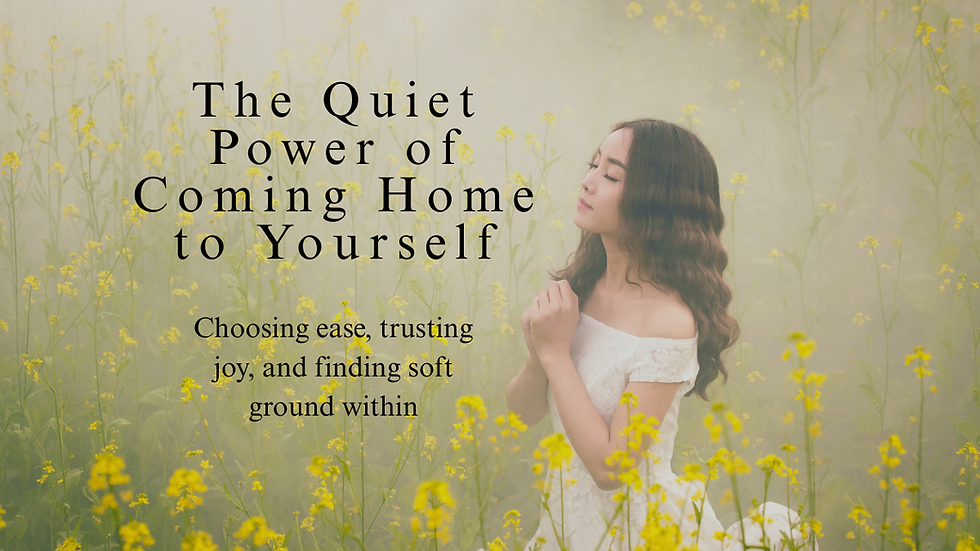My Breast Reduction Healing Routine for Skin Repair
- Shelley Beyer

- Sep 16
- 4 min read

Breast Reduction Scar Healing: What It Really Feels Like
There’s a part of healing that no one prepares you for.
Not the logistics — the drains, the swelling, the scars — but the quiet emotional work that starts once the surgery is over.
Especially after breast reduction, there’s a tender in-between space: not quite the beginning, not fully healed. Just… in process.
That’s where I’ve been.
If you’d rather watch this reflection, you can view the full video below. Otherwise, keep reading for a slower walk through what’s been helping me — not just physically, but emotionally too.
📺 Watch the video:
Do You Really Need a Scar Cream After Breast Reduction?
My doctor gave me the SkinMedica Scar Recovery Gel — it’s a good product, and he told me it was there if I wanted it.
I never used it.
Not because I thought it wouldn’t help, but because something in me was saying: focus inward.
I was more interested in what I could do to support my body from the inside — to give it what it needed to do the healing work on its own. I felt like that mattered more than anything I could apply topically.
And the thing is — my scars looked really good. They were flat, faint, and soft within just a few months. And I believe that had a lot to do with the inside-out support I gave myself during that time.
What I Gave My Body to Support Healing
In those early weeks, my instinct was to nourish.
I wasn’t trying to perfect my recovery or check off some ideal list — I just wanted to care for my body well.
One of the first things I leaned into was bone broth. Not homemade — I bought it from Costco. But it was warm, mineral-rich, collagen-supportive, and easy to sip on. I drank it almost every day. It wasn’t fancy, but it was supportive — and that’s what mattered.
I also took liposomal vitamin C, not because it was trendy, but because I knew it mattered. Vitamin C helps build collagen — and the liposomal form is easier for the body to absorb. That felt like a small way to make a big difference.
I increased my vitamin D3 with K2 to 20,000 IUs during recovery. I already took it regularly, but I wanted to be intentional. Vitamin D supports the immune system and healing. K2 helps keep calcium where it belongs. It wasn’t flashy, but it felt wise.
I added HealFast, a supplement rich in B vitamins, and took Arnica to support tissue recovery and reduce bruising.
None of this was about overdoing it. It was about staying present. Every capsule, every sip — it was just me saying to my body: I’m with you. I believe in you. Let’s take it one day at a time.
The Shift from Control to Trust
Something changed in me during this process.
In the past, I’ve sometimes approached healing with a subtle tension — like I had to manage it, make it happen. This time, I let go.
I didn’t check my scars every day. I didn’t panic when I wasn’t sure if I was doing “enough.”
Instead, I kept coming back to this quiet question: What does my body need today?
Some days that answer was broth. Some days it was rest. Some days it was letting go of guilt for not doing anything at all.
That was healing, too.
What I Would Tell Myself if I Could Go Back
If I could sit with the version of me who was fresh out of surgery, I’d say:
You don’t have to earn your healing. You don’t have to prove you’re doing enough. You are allowed to let this be simple.
I’d remind her that healing isn’t linear, and that scars continue to fade and flatten long after the early weeks.
I’d tell her to trust the process — even when she couldn’t see it working yet.
Breast Reduction Recovery: More Than Just Physical
What I’ve realized is that breast reduction recovery isn’t just physical.
Yes, we talk about scars and swelling and timelines — but there’s an emotional scar healing too. A reintroduction to the body. A new relationship with self-image, softness, and enough-ness.
This healing asks more than just ice packs and pillows. It asks for presence.
It asks us to believe that our bodies know how to heal — and that our job is to support that, not manage it.
What If Healing Is Happening Even When You Can’t See It?
This is the question that carried me:
What if healing is already happening… even when you can’t feel it?
Maybe you’re here, reading this, wondering if what you’re doing is enough.
And I want to say gently: if you are showing up with care — in rest, in nourishment, in intention — that is enough.
You don’t have to chase perfection. You don’t have to perform healing.
You are allowed to let this be slow. To let it be quiet.
To trust the good work your body is doing, even now.
I don’t have all the answers, but I do know this: healing is worth honoring, even when it feels ordinary.
Until next time...
Be gentle with your heart.
Be kind to your body.
And remember: Progress is happening, even when it’s quiet.
Warmly,
Shelley💛
Need more support in your breast reduction healing journey?
You’re always welcome to:
💌 Download the free guide: Fueling Your Body for Surgery
💬 Join the private group: Off the Rack: Breast Reduction Support for Women






.png)


Comments